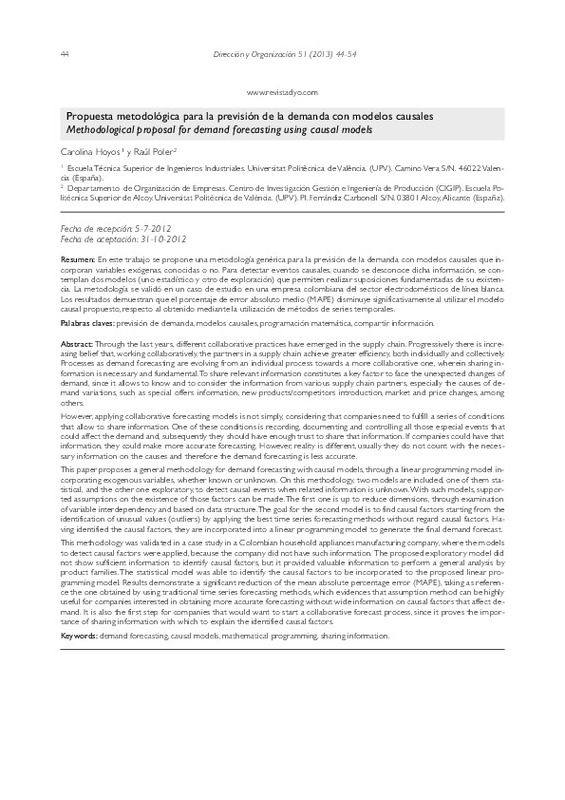JavaScript is disabled for your browser. Some features of this site may not work without it.
Buscar en RiuNet
Listar
Mi cuenta
Estadísticas
Ayuda RiuNet
Admin. UPV
Propuesta metodológica para la previsión de la demanda con modelos causales
Mostrar el registro sencillo del ítem
Ficheros en el ítem
| dc.contributor.author | Hoyos Marulanda, Carolina
|
es_ES |
| dc.contributor.author | Poler Escoto, Raúl
|
es_ES |
| dc.date.accessioned | 2015-06-02T11:34:33Z | |
| dc.date.available | 2015-06-02T11:34:33Z | |
| dc.date.issued | 2013-12 | |
| dc.identifier.issn | 1132-175X | |
| dc.identifier.uri | http://hdl.handle.net/10251/51143 | |
| dc.description.abstract | [EN] Through the last years, different collaborative practices have emerged in the supply chain. Progressively there is increasing belief that, working collaboratively, the partners in a supply chain achieve greater efficiency, both individually and collectively. Processes as demand forecasting are evolving from an individual process towards a more collaborative one, wherein sharing information is necessary and fundamental. To share relevant information constitutes a key factor to face the unexpected changes of demand, since it allows to know and to consider the information from various supply chain partners, especially the causes of demand variations, such as special offers information, new products/competitors introduction, market and price changes, among others. However, applying collaborative forecasting models is not simply, considering that companies need to fulfill a series of conditions that allow to share information. One of these conditions is recording, documenting and controlling all those especial events that could affect the demand and, subsequently they should have enough trust to share that information. If companies could have that information, they could make more accurate forecasting. However, reality is different, usually they do not count with the necessary information on the causes and therefore the demand forecasting is less accurate. This paper proposes a general methodology for demand forecasting with causal models, through a linear programming model incorporating exogenous variables, whether known or unknown. On this methodology, two models are included, one of them statistical, and the other one exploratory, to detect causal events when related information is unknown. With such models, supported assumptions on the existence of those factors can be made. The first one is up to reduce dimensions, through examination of variable interdependency and based on data structure. The goal for the second model is to find causal factors star ting from the identification of unusual values (outliers) by applying the best time series forecasting methods without regard causal factors. Having identified the causal factors, they are incorporated into a linear programming model to generate the final demand forecast. This methodology was validated in a case study in a Colombian household appliances manufacturing company, where the models to detect causal factors were applied, because the company did not have such information. The proposed exploratory model did not show sufficient information to identify causal factors, but it provided valuable information to perform a general analysis by product families. The statistical model was able to identify the causal factors to be incorporated to the proposed linear programming model. Results demonstrate a significant reduction of the mean absolute percentage error (MAPE), taking as reference the one obtained by using traditional time series forecasting methods, which evidences that assumption method can be highly useful for companies interested in obtaining more accurate forecasting without wide information on causal factors that affect demand. It is also the first step for companies that would want to star t a collaborative forecast process, since it proves the importance of sharing information with which to explain the identified causal factors. | es_ES |
| dc.description.abstract | [ES] En este trabajo se propone una metodología genérica para la previsión de la demanda con modelos causales que incorporan variables exógenas, conocidas o no. Para detectar eventos causales, cuando se desconoce dicha información, se contemplan dos modelos (uno estadístico y otro de exploración) que permiten realizar suposiciones fundamentadas de su existencia. La metodología se validó en un caso de estudio en una empresa colombiana del sector electrodomésticos de línea blanca. Los resultados demuestran que el porcentaje de error absoluto medio (MAPE) disminuye significativamente al utilizar el modelo causal propuesto, respecto al obtenido mediante la utilización de métodos de series temporales. | |
| dc.language | Español | es_ES |
| dc.publisher | Universidad Politécnica de Madrid | es_ES |
| dc.relation.ispartof | Dirección y Organización | es_ES |
| dc.rights | Reserva de todos los derechos | es_ES |
| dc.subject | Previsión de demanda | es_ES |
| dc.subject | Modelos causales | es_ES |
| dc.subject | Programación matemática | es_ES |
| dc.subject | Compartir información | es_ES |
| dc.subject | Demand forecasting | es_ES |
| dc.subject | Causal models | es_ES |
| dc.subject | Mathematical programming | es_ES |
| dc.subject | Sharing information | es_ES |
| dc.subject.classification | ORGANIZACION DE EMPRESAS | es_ES |
| dc.title | Propuesta metodológica para la previsión de la demanda con modelos causales | es_ES |
| dc.title.alternative | Methodological proposal for demand forecasting using causal models | es_ES |
| dc.type | Artículo | es_ES |
| dc.rights.accessRights | Abierto | es_ES |
| dc.contributor.affiliation | Universitat Politècnica de València. Centro de Investigación de Gestión e Ingeniería de la Producción - Centre d'Investigació de Gestió i Enginyeria de la Producció | es_ES |
| dc.contributor.affiliation | Universitat Politècnica de València. Departamento de Organización de Empresas - Departament d'Organització d'Empreses | es_ES |
| dc.description.bibliographicCitation | Hoyos Marulanda, C.; Poler Escoto, R. (2013). Propuesta metodológica para la previsión de la demanda con modelos causales. Dirección y Organización. 51:44-54. http://hdl.handle.net/10251/51143 | es_ES |
| dc.description.accrualMethod | S | es_ES |
| dc.relation.publisherversion | http://revistadyo.es/index.php/dyo/article/view/437 | es_ES |
| dc.description.upvformatpinicio | 44 | es_ES |
| dc.description.upvformatpfin | 54 | es_ES |
| dc.type.version | info:eu-repo/semantics/publishedVersion | es_ES |
| dc.description.volume | 51 | es_ES |
| dc.relation.senia | 265581 |






